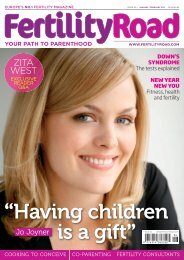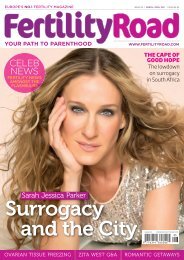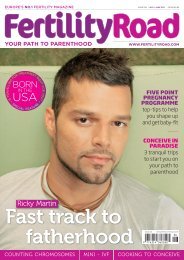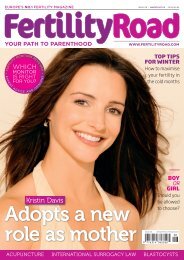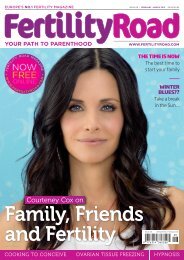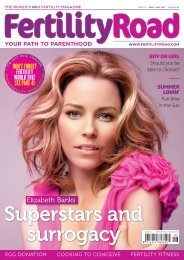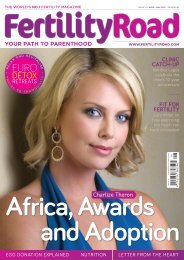Fertility Road Issue 03
Create successful ePaper yourself
Turn your PDF publications into a flip-book with our unique Google optimized e-Paper software.
INTERVIEW | Toni Weschler<br />
or ovulation tests when they are fertile, this advice<br />
seems dismissive and dumbed down.<br />
“Doctors insult women who chart to get pregnant by<br />
rolling their eyes,” notes Weschler. “Yet no doctor can<br />
know a woman’s body better than she does.”<br />
The charting pioneer, who lives in Seattle, believes that<br />
it’s still the case that not enough of us are fertility-aware,<br />
and this could well be at the root of struggles to conceive,<br />
ironically despite all the high-tech options now on offer. The<br />
low-tech, DIY methods of fertility charting are, Weschler<br />
feels, by contrast a simple and reliable knowledge base.<br />
“Of all of the fertility treatments developed in the past<br />
few decades, IVF has undoubtedly helped more couples<br />
than any other, which is extraordinary. But its appeal as<br />
the end-all, be-all, is also insidious,” she says.<br />
“I have major concerns about women being put through<br />
this incredibly expensive and invasive procedure when they<br />
have not been taught the most fundamental information<br />
necessary to achieve pregnancy: the <strong>Fertility</strong> Awareness<br />
Method. By charting their cycles, they may be able to conceive<br />
on their own by simply learning how to identify their<br />
most fertile phase, or potential problems that can be easily<br />
rectified before moving onto something as invasive as IVF.”<br />
So at what point should fertility charting take second<br />
place to medical treatment like IVF? “If a couple is officially<br />
diagnosed with a physical problem such as blocked tubes,<br />
then no amount of charting is going to help them to conceive,”<br />
says Weschler. “But in most other cases, charting<br />
works beautifully in conjunction with fertility treatments<br />
to help the couple take control of their medical management,<br />
rather than feeling like it is all being done to them.<br />
“Ultimately, if a couple has actively timed intercourse<br />
perfectly for at least 4-6 cycles (for women 35 and over)<br />
or 6-8 cycles (for women younger than 35), then it is<br />
time to seek medical treatment. But the operative phrase<br />
here is ‘timed perfectly’. That means that they know her<br />
cycle so well that they know if she is ovulating altogether<br />
and they have consistently timed intercourse around ovulation.”<br />
Some women can’t be bothered with charting (“It just makes<br />
me think ‘maths’’’, says Sophie, a 32-year-old photographer, in<br />
horror), and the average man would rather eat his own fist than<br />
check out his wife’s chart. But the practice appeals enormously to<br />
women who like to have a plan.<br />
Still, taking your temperature can too easily become the focal<br />
point of each day. You irrationally find yourself looking at<br />
your chart every few hours in case it tells you you’re pregnant, or<br />
worrying over signs and symptoms.<br />
Weschler stresses that charting should be about seeing “the<br />
big picture, not obsessing over one single temperature or letting<br />
your life get consumed by minutiae.” Still merrily ovulating, and<br />
charting on paper, she sees charting, when done right, as a worthy<br />
object of one’s attention and pride. “I’ve been charting 28 years and<br />
my charts are a thing of beauty - I love showing them to people! Seeing<br />
the patterns of what a woman’s body does is a fascinating privilege.<br />
Still, at a certain point, you do have to get on with everyday life.”<br />
So if she could give one piece of advice to a couple wanting a<br />
baby, what would it be? “It would be to focus on her cervical<br />
fluid,” says Weschler. “She should try to have intercourse every<br />
Doctors insult women who chart<br />
to get pregnant by rolling their eyes,<br />
yet no doctor can know a woman’s<br />
body better than she does.<br />
day that she has wet, slippery cervical fluid at her vaginal<br />
opening - or every other day if the man’s sperm count is low.”<br />
Of course, fertility awareness doesn’t end with pregnancy<br />
achievement. It is an invaluable tool for women dealing with troublesome<br />
or irregular periods, PMS or menopause, and can be used<br />
as a form of natural birth control. Weschler’s second book, Cycle<br />
Savvy, educates teenage girls about the female reproductive system.<br />
Hopefully, with her influence, the next generation of women<br />
will grow up with a greater understanding of their bodies.<br />
Taking Charge of Your <strong>Fertility</strong> by<br />
Toni Weschler is published by Vermilion<br />
at £20; however this British edition<br />
of 20<strong>03</strong> has not been revised like<br />
the American one over the years,<br />
and Weschler, who is currently busy<br />
revising another American edition due<br />
in 2012, recommends British readers<br />
buy the more up-to-date American<br />
version published by Collins in 2006<br />
(available from Amazon.com from $8).<br />
28 fertility road | november - december





